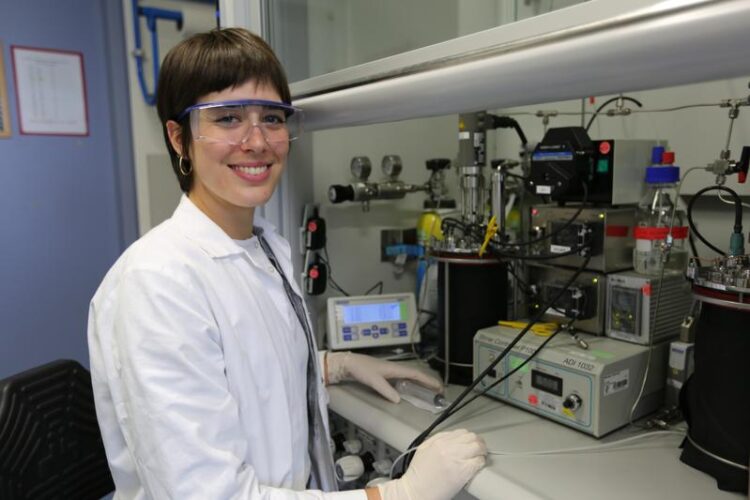Breathing poison: Microbial life on nitric oxide respiration

Paloma Garrido Amador next to the bioreactor setup, which has been housing the NO-respiring microorganisms for more than four years now in a lab in the Max Planck Institute for Marine Microbiology.
Credit: Alexandra Krüger / Max Planck Institute for Marine Microbiology
Nitric oxide (NO) is a central molecule in the global cycling of nitrogen, and also toxic.
Little is known about if and how microbes can use NO as a substrate for growth. Scientists from the Max Planck Institute for Marine Microbiology in Bremen, Germany, have now managed to grow a microbial community dominated by two, so-far unknown species on NO for more than four years (and counting) and study their metabolism in great detail. Their research, now published in in Nature Microbiology, provides insight into the physiology of NO-reducing microorganisms, which have pivotal roles in the control of climate active gases, waste removal, and the evolution of nitrate and oxygen respiration.
Nitric oxide (NO) is a fascinating and versatile molecule, important for all living things as well as the environment. It is highly reactive and toxic, organisms use it as a signaling molecule, it depletes the ozone layer in our planet’s atmosphere, and it is the precursor of the greenhouse gas nitrous oxide (N2O). Moreover, NO might have played a fundamental role in the emergence and evolution of life on Earth, as it was available as a high-energy oxidant long before there was oxygen.
Thus, despite its toxicity, it makes perfect sense that microbes use NO to grow. However, research on the topic is scarce and, to date, microbes growing on it have not been cultivated. That has now changed, as reported by scientists around Paloma Garrido Amador and Boran Kartal from the Max Planck Institute for Marine Microbiology in Bremen, Germany, in the journal Nature Microbiology. They have managed to enrich two yet unknown species of microorganisms growing on NO in bioreactors and reveal exciting aspects of their lifestyle.
From the wastewater tank to the bioreactor
The study started off with a trip to Bremen’s wastewater treatment plant. “We collected sludge from their denitrifying tank”, Garrido Amador tells. “Back in our lab, we added the sludge to one of our bioreactors and we started the incubation by feeding it with NO.” Bioreactors are designed and optimized to grow microorganisms under controlled conditions, which closely mimic their natural environment. This bioreactor setup was very challenging, though, Garrido Amador reports, “Because NO is toxic, we needed special equipment and had to take great care when handling them for our own safety. Nevertheless, we managed to keep the cultures growing for more than four years now – and they are still happy and healthy!”
Two new microorganisms
The living conditions in the bioreactor thus favored microorganisms that could survive and grow anaerobically with NO. “Eventually, two previously unknown species turned out to dominate the culture”, says Boran Kartal, group leader of the Microbial Physiology Research Group the Max Planck Institute in Bremen. “We named them Nitricoxidivorans perserverans and Nitricoxidireducens bremensis.” Garrido Amador adds, “From just two microorganisms growing on NO, we gained valuable insight into how non-model microorganisms, in particular NO-reducers grow. Some of our observations showed us that these microbes did not conform to how model organisms – organisms which easily cultivated and thus extensively studied – behave, and showcased the limitations of metabolic predictions based solely on genome analyses.”
Importance in the environment and applications for waste removal
“Currently we know little about the contribution of microorganisms growing on NO to nitrogen cycling in natural and engineered environments”, explains Kartal. “Nevertheless, we can speculate that these microorganisms could potentially be feeding on NO and N2O released by other microorganisms while removing nitrosative stress and minimizing the emission of these climate active gases to the atmosphere.”
The enriched microorganisms converted NO to dinitrogen (N2) very efficiently. “There were virtually no emissions of the greenhouse gas nitrous oxide”, Kartal adds. The latter – the sole production of N2 – is particularly relevant for application: Many other microorganisms convert NO to nitrous oxide, which is a potent greenhouse gas. N2, in contrast, is harmless. Thus, each molecule of NO that is transformed into N2 instead of nitrous oxide is one less molecule adding to climate change.
In a next step, the Max Planck researchers are cultivating other NO-respiring microorganisms using samples from natural and engineered environments. “Cultivation and enrichment of further NO-respiring microorganisms will help to elucidate the evolution of N-oxide reduction pathways and the enzymes involved. It will also allow to decipher the role of NO in known and yet-unknown processes of the nitrogen cycle and its importance in the natural and engineered environments where these processes take place.”, Garrido Amador concludes.
Wissenschaftliche Ansprechpartner:
Paloma Garrido Amador
PhD-student
Max Planck Institute for Marine Microbiology, Bremen, Germany
Microbial Physiology Research Group
Phone: +49 421 2028-6530
E-Mail: pgarrido@mpi-bremen.de
Dr. Boran Kartal
Group Leader
Max Planck Institute for Marine Microbiology, Bremen, Germany
Microbial Physiology Research Group
Phone: +49 421 2028-6450
E-Mail: bkartal@mpi-bremen.de
Originalpublikation:
Paloma Garrido-Amador, Niek Stortenbeker, Hans J.C.T. Wessels, Daan R. Speth, Inmaculada Garcia-Heredia, Boran Kartal (2023): Enrichment and characterization of a nitric oxide-reducing microbial community in a continuous bioreactor. Nature Microbiology (2023). Published online July 10, 2023.
DOI: 10.1038/s41564-023-01425-8
Weitere Informationen:
https://www.mpi-bremen.de/en/Page6071.html Press release of MPIMM
Media Contact
All latest news from the category: Life Sciences and Chemistry
Articles and reports from the Life Sciences and chemistry area deal with applied and basic research into modern biology, chemistry and human medicine.
Valuable information can be found on a range of life sciences fields including bacteriology, biochemistry, bionics, bioinformatics, biophysics, biotechnology, genetics, geobotany, human biology, marine biology, microbiology, molecular biology, cellular biology, zoology, bioinorganic chemistry, microchemistry and environmental chemistry.
Newest articles

For microscopic organisms, ocean currents act as ‘expressway’ to deeper depths
New research shows how tiny plant-like organisms hitch a ride on ocean currents to reach darker and deeper depths, where they impact carbon cycling and microbial dynamics in the subtropical…

FDmiX: Fast, robust series production of nanoparticles
Nucleic acid-based medications such as mRNA vaccines are opening up new therapeutic approaches. These active ingredients must be enclosed inside nanoparticles to ensure that they get to where they are…

Sensor measures oxygen content of breath
Oxygen saturation in the blood that is either too low or too high can cause physical harm or even death. This is why patients’ oxygen concentraions are monitored continuously in…





















